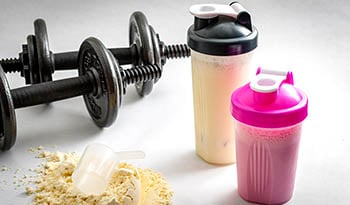How To Track Your Progress When Bulking
DISCLAIMER:This blog does not intend to provide diagnosis...
- In this article:
- What Is Bulking?
- Bulking Progress Variables
- How to Track Bulking Progress
- Bulking Progress Takeaways

When progressing through one’s lifting career, it’s common to go through gaining or “bulking” phases in order to gain as much muscle as possible. The use of gaining phases is not for everyone, however, if you are on a quest to maximize muscle growth and increase performance metrics that are—at times—closely related to being heavier, like strength, then they can be worth exploring.
The only caveat with using gaining phases is that they can at times be counterproductive when a strategy is missing from one’s plan. This entails the lifters that say they’re “bulking” and use that as a blanket for eating whatever they want and neglecting dietary habits that they had established prior to their gaining phase.
Despite being in a gaining phase, we should still make a conscious effort to utilize strategy and to track metrics along the way. This can ensure we’re being efficient with our plan, but also mitigate excessive fat gain that doesn’t necessarily need to occur at a rapid rate. Basically, if we track metrics as we go, we can shift our plan up or down based on our goals and trends we’re noticing.
What Is Bulking?
Before we dive into tracking progress when bulking, let’s first discuss what bulking is. Bulking or gaining is the process of increasing caloric intake past one’s Total Daily Energy Expenditure (TDEE) in order to maximize muscle growth. Bulking diets will often be accompanied by a training plan that is also designed to maximize growth potential with the surplus of calories.
Bulking or gaining phases will generally be determined by a set amount of time or weight gain goals one wants to accomplish. Both of these are important to acknowledge as they can play into the strategy used to determine how large one’s surplus will be and if it’s a realistic and feasible plan that coincides with a lifter’s lifestyle and habits. Weight gainers can help you reach your daily caloric intake if you struggle to get there through diet alone.
Want to Start Building Muscle? Here are 3 Considerations for Men: Read more.
Bulking Progress Variables
As we dive into tracking bulking progress, it’s essential to recognize that we’ll need a few variables established before haphazardly diving into a gaining phase. These variables include:
- Current TDEE: We need to know our current intake to then create a daily surplus amount that aligns with our goals and starting point.
- Body starting points: On top of knowing our TDEE, we also should acknowledge our current body fat levels and body composition, as this can help us select a strategic surplus amount and also help us more fluidly track body composition progress.
- Gaining goals: What are you trying to accomplish with your gaining phase? Is it weight-centric? Or are you gaining for performance?
Once you’ve established these basic tenants, you can then begin selecting how you want to track bulking progress. Do note, in this article, we’re specifically talking about tracking progress and you’ll have to set up your bulking structure based on the context of your life, goals, and needs!
How to Track Bulking Progress
While tracking progress is important, we also need to establish starting points because this can highlight how far we’ve gone on multiple fronts when gaining. It’s a good idea to have the following logged when starting a gaining phase.
- Bodyweight
- Body fat (an average will suffice)
- Performance metrics, like 1-RMs, activity-focused times, etc.
Once you have these logged, there are multiple ways to track progress when bulking.
My advice is to use bodyweight and then another metric provided below. By using two metrics, we can stay a bit more objective with our progress and gain better insights into the bigger picture of our goals and gaining phase.
1. Track Bodyweight
The first and easiest metric to track is your body weight. With body weight, it’s normal to see daily fluctuations especially when consuming more, so it’s wise to log your body weight a minimum of three days a week as this can provide you with an average. Trends and averages will always be preferred over singular days — remember, we want to make small, educated shifts, not reactive grandiose ones, and trends help us do so.
When tracking your body weight, try to do so first thing in the morning when you wake up before consuming food or fluids. This will provide you with a better idea of where your weight is likely consistently sitting.
In reference to body weight and shifting bulking parameters, try to use weekly bodyweight trends to dictate shifts. For example, if you notice from week 3 to week 4 you’ve gained much more than you wanted and your weight is consistently higher through week 4, then scale back intake slightly. Vice versa for situations where gaining is going slower than desired.
2. Progress Photos
Another useful tool is taking progress photos. These require little effort and can be used for additional motivation during a gaining phase. Ideally, you’ll want to take progress photos in the morning when you’re weighing yourself so before you eat or drink anything.
You can obviously take progress photos during the day, too, and after workouts (I encourage you to do so!), but for progress tracking purposes — try to keep a streamline of photos reserved for morning shots to accurately gauge where potential muscle and fat gain are occurring.
With morning progress photos specifically, try to take them a minimum of 1-3 times a week. Remember, we’re going off of trends and one photo may not be able to paint the full picture for our progress!
3. Third-Party Body Fat Testing
If you want to get more accurate with your progress, then using third-party body fat testing tools can be an awesome way to dial in your accuracy. There are multiple tools one can use to track their body fat levels and the amount gained during a bulking phase.
Some popular options can be seen below. I’m listing them from more accurate to less!
- DEXA Scan
- Bod Pod/Hydrostatic Weighing
- Skin Calipers
- Bioelectrical Impedance Analysis
All of these options are fantastic to use in addition to bodyweight metrics. If you’re going to use some of the more accurate and expensive options, then using them once every three or four weeks is usually a good bet. You can also use them before and after your gaining phase if you have limited resources for utilizing them (they can be expensive!).
A Doctor Debunks 8 Myths About Metabolism and Weight Loss: Read more.
Bulking Progress Takeaways
A great bulk should be composed of strategy and multiple metrics for tracking progress. It’s usually a good idea to use two methods from the above list for tracking progress to ensure excessive fat gain is mitigated during a bulk.
Some fat gain is inevitable when bulking, and that’s okay, however, we do want to be mindful of how much we’re putting on in regard to our starting points and what will make us feel and perform our best.
When in surplus phases, remember to optimize things like:
- Protein Intake: If you’re struggling to get enough protein or calories, then consider weight gainer supplements!
- Pre and Post-Workout Nutrition: Since you’re in a surplus phase, double down on your pre-workout and post-workout nutrition to perform your best and optimize gains.
- Recovery Is King: We build the most when we’re recovering, so consider supplementing things like magnesium for sleep, vitamin D for the colder months, and even some zinc for additional immune support.
These are only a few aspects to consider when bulking. If you’re in a surplus phase, use the additional calories for growth and get after it. Happy bulking!
What To Eat Before and After Heavy Training Sessions: Read More.

 By Jake Boly, CSCS
By Jake Boly, CSCS


